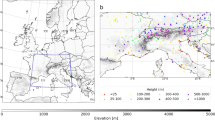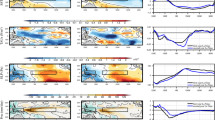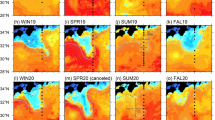Summary
The baroclinic development of an intense meso-scale cyclone (MC) over the Weddell Sea near the Antarctic coast close to the German Georg-von-Neumayer Station (GvN) during the period 26–28 April 1989 was studied by means of satellite and conventional data. ECMWF analyses, radiosonde data and surface observations were used together with AVHRR data, TOVS and SSM/I retrievals for the description of the synoptic and subsynoptic environment associated with the development of the MC. The MC had a diameter of about 500 km, a lifetime of about 40 hours and reached the intensity of a polar low. Wind speeds up to 19 m/s (with gusts up to 24 m/s) were recorded at GvN as the MC approached on 27 April and remained quasi-stationary for about 24 hours. Its development took place in baroclinic conditions of strong low-level cold air advection close to the sea ice front. The genesis of the MC seemed to be triggered by a 500 hPa short-wave trough and a resemblance to a baroclinic development at a boundary layer front was noticed. Low-level thickness fields from TOVS data reflected the baroclinic structure of the MC, but gradients were relatively weak. Wind speed retrievals from SSM/I data did not allow a full analysis of the wind field structure for this case, as they were limited to ice-free ocean. They showed the incipient MC lying in an area with increased wind speed and high surface fluxes of sensible heat. In the mature stage, a maximum in the SSM/I wind speed field was found in the northwestern part of the MC. A meso-scale analysis with a limited area assimilation system for the mature stage showed only weak support of the low-level MC by upper level cyclonic vorticity advection.
Similar content being viewed by others
References
Baum, B. A., Wielicki, B. A., Minnis, P., Parker, L., 1992: Cloud-Property Retrieval Using Merged HIRS and AVHRR Data.J. Appl. Meteor.,31, 351–369.
Bengtsson, L., 1991: Advances and prospects in numerical weather prediction.Quart. J. Roy. Meteor. Soc.,117, 855–902.
Businger, S., Reed, R. J., 1989: Cyclogenesis in cold air masses.Weather and Forecasting,4, 133–156.
Carrasco, J. F., Bromwich, D. H., 1993: Mesoscale cyclogenesis dynamics over the southwestern Ross Sea.J. Geophys. Res.,98, 12973–12995.
Cavalieri, D. J., Crawford, J. P., Drinkwater, M. R., Eppler, D. T., Farmer, L. D., Jentz, R. R., Wackermann, C. C., 1991: Aircraft active and passive microwave validation of sea ice concentration from the Defense Meteorological Satellite Program Special Sensor Microwave Imager.J. Geophys. Res.,96, 21989–22008.
Chedin, A., Scott, N. A., Wahiche, C., Moulinier, P., 1985: The Improved Initialisation Inversion method: A high resolution physical method for temperature retrievals from satellites of the TIROS-N series.J. Climate. Appl. Meteor.,24, 128–143.
Chedin, A., Scott, N. A., Wahiche, C., Moulinier, P., Husson, N., Sitbon, P., 1986: The “3I” procedure applied to the retrieval of meteorological and climate parameters from NOAA-7.Ocean-Air Interactions,1, 29–42.
Claud, C., Scott, N. A., Chedin, A., 1992: Use of TOVS observations for the study of polar and Arctic lows.Int. J. Remote Sensing,13, 129–139.
Claud, C., Mognard, N. M., Katsaros, K. B., Chedin, A., Scott, N. A., 1993: Satellite observations of a polar low over the Norwegian Sea by the Special Sensor Microwave Imager, Geosat, and the TIROS-N Operational Vertical Sounder.J. Geophys. Res.,98, 14487–14506.
Duncan, C. N., 1978: Baroclinic instability in a reversed shear flow.Meteor. Magazine.,107, 17–23.
Fett, R. W., 1989: Polar low development associated with boundary layer fronts in the Greenland, Norwegian and Barents Seas. In: Twitchell, P. F., Rasmussen, E. A., Davidson, K. L. (eds.)Polar and Arctic Lows, Hampton, Virginia, USA: Deepak Publishing 421 pp.
Goodberlet, M. A., Swift, C. T., Wilkerson, J. C., 1989: Remote sensing of ocean surface winds with the Special Sensor Microwave/Imager.J. Geophys. Res.,94, 14547–14555.
Grønås, S., Foss, A., Lystad, M., 1987: Numerical simulations of polar lows over the Norwegian Sea.Tellus,39A, 334–353.
Harrold, T. W., Browning, K. A., 1969: The polar low as a baroclinic disturbance.Quart. J. Roy. Meteor. Soc.,95, 710–723.
Heinemann, G., 1989: On the use of TOVS data for studies of mesoscale vortices in the Weddell Sea (Antarctica). Technical Proceedings Fifth International TOVS Study Conference, Toulouse, France, 184–200.
Heinemann, G., 1990: Meso-scale vortices in the Weddell Sea region.Mon. Wea. Rev.,118, 779–793.
Heinemann, G., Rose, L., 1990: Surface energy balance, parameterizations of boundary layer heights and the application of resistance laws near an Antarctic ice shelf front.Bound. Layer Meteor.,51, 123–158.
Heinemann, G., Noël, S., Chedin, A., Scott, N. A., Claud, C., 1995: Sensitivity studies of TOVS retrievals with 3I and ITPP retrieval algorithms: Application to the resolution of meso-scale phenomena in the Antarctic.Meteorol. Atmos. Phys.,55, 87–100.
Heinemann, G., 1995: TOVS retrievals obtained with the 3I-algorithm: A study of a meso-scale cyclone over the Barents Sea.Tellus,47A, 324–330.
Hollinger, J. P., Lo, R., Poe, G., Savage, R., Pierce, J., 1987: Special Sensor Microwave/Imager user's guide. Report, Naval Research Laboratory, Washington D.C., 120 pp.
Kelly, G., Andersson, E., Hollingsworth, A., Lönnberg, P., Pailleux, J., Zhang, Z., 1991: Quality control of operational physical retrievals of satellite sounding data.Mon. Wea. Rev.,119, 1866–1880.
Kidwell, K. B., 1991:NOAA Polar Orbiter Data Users Guide. Washington, D.C.: NOAA/NESDIS.
Köpken, C., Heinemann, G., 1993: Assessment of the quality of TOVS retrievals obtained with the 3I-algorithm for Antarctic conditions. Technical Proceedings Seventh International TOVS Study Conference, Igls, Austria, 256–268.
Lachlan-Cope, T. A., 1989: The use of TOVS data in Antarctica. Technical Proceedings Fifth International TOVS Study Conference, Toulouse, France, 224–246.
Lutz, H. J., Smith, W. L., Raschke, E., 1990: A note on the improvement of TIROS operational vertical sounder temperature retrievals above the Antarctic snow and ice fields.J. Geophys. Res.,95, 11747–11754.
McClain, E. P., Pichel, W. G., Walton, C. C., 1985: Comparative performance of AVHRR based multi-channel sea surface temperatures.J. Geophys. Res.,90, 11587–11601.
Midbø, K. H., Grønås, S., Lystad, Nordeng, T. E., 1989: Analyses of polar lows in the Norwegian Sea with a mesoscale limited area numerical weather prediction system. In: Twitchell, P. F., Rasmussen, E. A., Davidson, K. L. (eds.)Polar and Arctic Lows, Hampton, Virginia, USA: A. Deepak Publishing, 421 pp.
Monck, G. A., 1992: Synoptic and mesoscale analysis of intense mid-latitude cyclones.Meteor. Magazine,121, 269–283.
Neiman, P. J., Shapiro, M. A., 1993: The life cycle of an extratropical marine cyclone. Part I: Frontal-cyclone evolution and thermodynamic air-sea interaction.Mon. Wea. Rev.,121, 2153–2176.
Nordeng, T. E., 1990: A model-based diagnostic study of the development and maintenance mechanism of two polar lows.Tellus,42A, 92–108.
Nordeng, T. E., Rasmussen, E. A., 1992: A most beautiful polar low. A case study of a polar low development in the Bear Island region.Tellus,44A, 81–99.
Orlanski, I., 1975: A rational subdivision of scales of atmospheric processes.Bull. Amer. Meteor. Soc.,56, 527–530.
Rasmussen, E. A., 1979: The polar low as an extratropical CISK disturbance.Quart. J. Roy. Meteor. Soc.,105, 531–549.
Rasmussen, E. A., Turner, J., Twitchell, P. F., 1993: Report of a workshop on applications of new forms of satellite data in polar low research, held at Hvanneyri, Iceland, 23–26 June 1992.Bull. Amer. Meteor. Soc.,74, 1057–1073.
Saunders, R. W., 1986: An automated scheme for the removal of cloud contamination from AVHRR radiances over western Europe.Int. J. Remote Sensing,7, 867–886.
Saunders, R. W., Kriebel, K. T., 1988: An improved method for detecting clear sky and cloudy radiances from AVHRR data.Int. J. Remote Sensing,9, 123–150.
Scott, N. A., Chedin, A., Achard, V., Bonnet, B., Cheruy, F. Claud, C., Escobar, J., Husson, N., Rieu, H., Tahani, Y., Tournier, B., 1991: Recent advances in the thermodynamic analysis of the earth system through the 3I algorithm. Technical Proceedings Sixth International TOVS Study conference, Airlie, Virginia, 425–467.
Shapiro, M. A., Keyser, D., 1990: Fronts, jet streams and the tropopause. In: Newton, C., Holopainen, E. O. (eds.)Extratropical Cyclones. Boston; Amer. Meteor. Soc., Boston, 266 pp.
Smith, W. L., Woolf, H. M., Hayden, C. M., 1979: The TIROS-N Operational Vertical Sounder.Bull. Am. Meteor. Soc.,58, 1177–1187.
Sortais, J.-L., Cammas, J.-P., Yu, X.D., Richard, E., Rosset, R., 1993: A case study of coupling between low- and upper-level jet-front systems: Investigation of dynamical and diabatic processes.Mon. Wea. Rev.,121, 2239–2253.
Turner, J., Lachlan-Cope, T. A., Moore, J. C., 1992: A comparison of satellite sounding data and aircraft measurements within a mature polar low.Tellus,44A, 119–132.
Turner, J., Lachlan-Cope, T. A., Thomas, J. P., 1993a: A comparison of Arctic and Antarctic mesoscale vortices.J. Geophys. Res.,98, 13019–13034.
Turner, J., Lachlan-Cope, T. A., Warren, D. E., 1993b: A mesoscale vortex over Halley Station, Antarctica.Mon. Wea. Rev.,121, 1317–1336.
Twitchell, P. F., Rasmussen, E. A., Davidson, K. L., 1989:Polar and Arctic Lows. Hampton, Virginia, USA: A. Deepak Publishing, 421 pp.
Author information
Authors and Affiliations
Additional information
Paper dedicated to Prof. H. Kraus.
With 17 Figures
Rights and permissions
About this article
Cite this article
Heinemann, G. A wintertime polar low over the eastern Weddell Sea (Antarctica): A study with AVHRR, TOVS, SSM/I and conventional data. Meteorl. Atmos. Phys. 58, 83–102 (1996). https://doi.org/10.1007/BF01027558
Received:
Published:
Issue Date:
DOI: https://doi.org/10.1007/BF01027558




